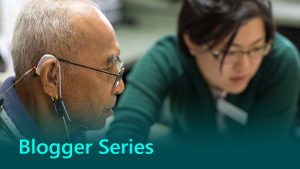
Inclusivity – the spark behind innovation

Some of the best innovations come from answering the challenges that people with disabilities face. Kerri Hollis looks at some of the ideas coming out of Microsoft and explains why inclusivity isn’t an obligation. It’s an opportunity for smart companies to innovate.
Imagine the moment you walk into a room, an app on your phone starts to describe what it can see. Or while you’re out shopping, the same app tells you all about a product. It lets you know its name, its ingredients, and even how to prepare it.
It’s called Seeing AI. And it’s a sort of intelligent camera app that tells you about the world around you. If that sounds handy, imagine how it could change life for a person with a visual impairment. Is that a bit of luck? Not at all. Seeing AI came out of a hackathon led by Saqib Shaikh, a blind coder at Microsoft. As Saqib says, “As someone who is visually impaired, this has become a key tool in my daily life.”
Impressive as Seeing AI is, it’s not alone. People with disabilities and the challenges they face are behind a lot of today’s exciting ideas.
Here’s another example. What happens if you’re visually impaired and aren’t sure of your surroundings? Check out Microsoft Soundscape. It uses innovative audio tech to help people get a better feel for where they are, what’s going on around them and so on. And once they’ve got that, they quickly get confident.
Inclusivity drives innovation
Smart companies today see inclusivity as a way to get real innovation in their business. The best way to look at it is that people with disabilities are real-life problem solvers. They face challenges every day. And they take them on and win. That helps them develop different skills. And as a result, they often find ways to solve problems other people wouldn’t think of. So, when those people develop ideas in your business, they’re likely to come up with ones packed with imaginative thinking.
Include the world in your design
Around 20% of the UK population have a disability. But being inclusive will help more than just that 20%. It’ll start to help you connect with all your potential customers. That’s because most accessibility tools have value for everyone. It doesn’t matter whether they have a disability or not. Sure, visually impaired people benefit greatly from apps like Seeing AI or Soundscape. But those apps could just as easily help a fully-sighted person.

And of course, if a tool helps someone with a permanent disability to do great work, it can do the same for someone whose disability’s only temporary. Microsoft Dictate is a great help for those with mobility limitations, for example. But it can be just as useful for someone recovering from a broken arm.
If you were at the recent Disability Confident Event, you may have heard Hector Minto talking about this. He’s the Technology Evangelist for Accessibility at Microsoft. As he said, “People with disabilities are having an amazing impact on our product. When we innovate around [them], we just end up with amazing products that suits a much wider range of people.”
Inclusivity – another word for opportunity
So what should we be aiming for? Well, in the end, it’s society’s attitudes that hold people with disabilities back. Accessibility isn’t an obligation. It’s a great enabler. When it’s put to good use the results can be fantastic. Because everyone will finally have the freedom to create and do great work. And as Hector said, giving people with disabilities the power to do more will benefit everyone.
Find out more
Our journey to accessibility
About the author
I have been at Microsoft for almost seven years and have worked across sales, partner, and now the Business Group. I often think about what I love most and quite simply it’s about making life easier for people – why should you need to check a hundred different places for information? Why should it not just be at your finger tips? That’s exactly why I lead the Microsoft UK Accessibility V-team. We’re responsible for empowering every individual on the planet to achieve more, regardless of physical or mental ability.




